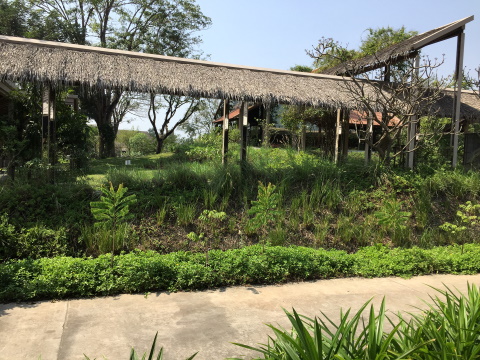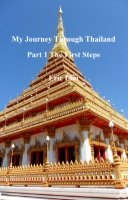| Back to Back Issues Page |
 |
|
Bangkok Travelbug Mar 2021 Suan Sampran – back to nature March 09, 2021 |
| Hello
In the early 1960s, a man and his wife were taking a boat ride along the Tha Chin River in Nakhon Pathom. They passed an area called Sampran and saw a 100-year-old Pikul* tree that was about to fall into the river owing to erosion of the river banks. This scene of nature's gradual destruction spurred them to buy the land and build a vacation home in an attempt to preserve nature. In 1962, they started a rose garden and welcomed visitors from Bangkok wishing to take a break from the hectic city. That garden soon became known as the Rose Garden, a popular tour in an itinerary for visitors to Bangkok. The project started by Dr Chamnan and his wife Khunying** Valee Yuvaboon has now grown in a huge enterprise within 50 acres (20.23 hectares) of land consisting of a resort, facilities dedicated to the preservation of Nature, organic farming, a market selling organic produce and a traditional Thai village to promote eco-friendly activities. 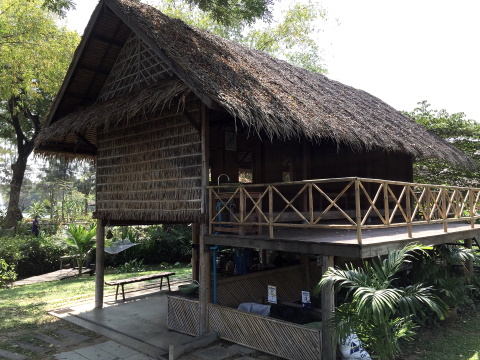
Traditional Thai house in Suan Sampran The management of this family enterprise, Suan Sampran has now gone into the third generation of the family. Note: *Pikul – Mimusops elengi or Bulletwood tree an evergreen tree known for its timber, scented flowers and edible fruits with medicinal value. **Khunying – an aristocratic title awarded by the King to women. There are two such titles in order of precedence; Thanpuying and Khunying. Contents Riverside resort The riverside resort consists of a hotel in a conventional concrete building, teak chalets in the form of traditional Thai houses and a Chinese pavilion for weddings and other functions on the banks of a huge lake. The resort and its food and beverage outlets form an integral part of the organic and eco-friendly projects of Suan Sampran. Organic farm products for the kitchen are produced by the organic farm on site and the farmers engaged in an organic farming project started by Suan Sampran. 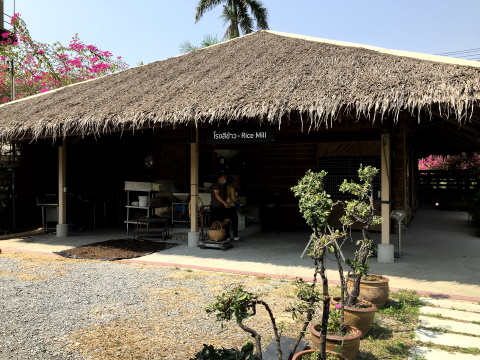
Rice mill in the organic farm Waste from the resort is recycled into organic fertiliser, animal and worm feed. Used vegetable oil is recycled into biodiesel for use in the resort and its facilities. No foam or plastics are used in Suan Sampran. The resort and its F & B outlets were closed during our visit owing to the pandemic. Contents Organic farming and food products In 2014, Suan Sampran started the Sookjai Foundation to initiate the Sampran Model, a business model to foster organic farming. This model consists of 16 groups of 170 farmers who engage in organic farming. Suan Sampran buys the organic produce from these farmers for use in the food and beverage outlets in the resort. This amounts to about 70% of their requirements. The rest are met from, the Patom Organic Farm their own 12 acre (4.84 hectares) organic farm within the grounds of Suan Sampran. 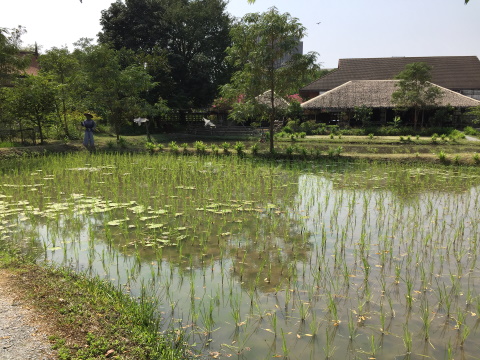
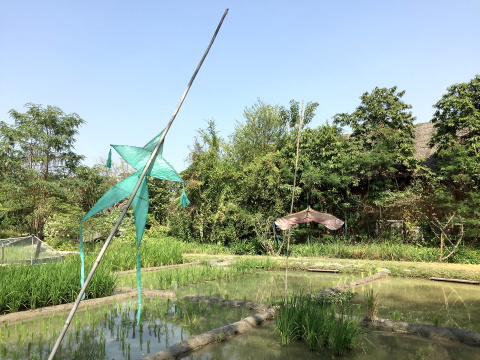
Rice fields in the organic farm 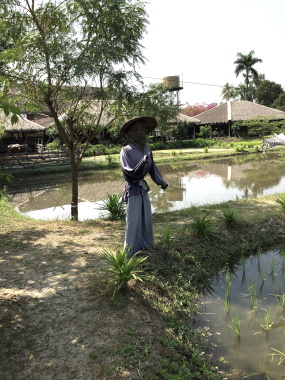
I almost mistook this for a real farmer 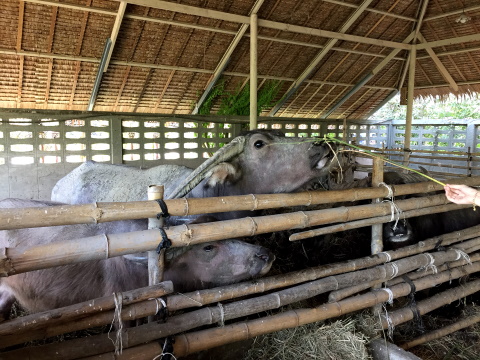
Buffalos are used to till the fields and their dung is used to produce fertiliser 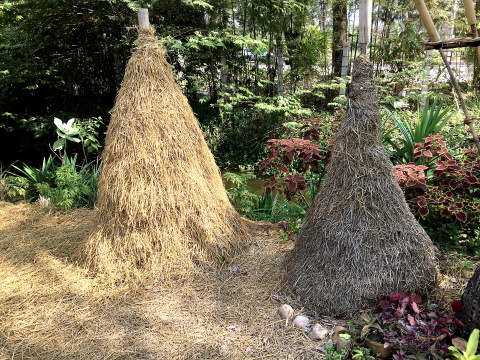
Hay to feed the buffalos The food and body care products made from this organic farm are marketed under the Patom Brand. Co-located with the organic farm is the Patom Organic Village a traditional Thai village where there are workshops for visitors to learn the various aspects of organic farming. These workshops include clay pottery, garland making, banana leaf weaving. Activities within this village will also help visitors understand the process in the production of these organic products. Unfortunately owing to the pandemic, these workshops were not conducted. 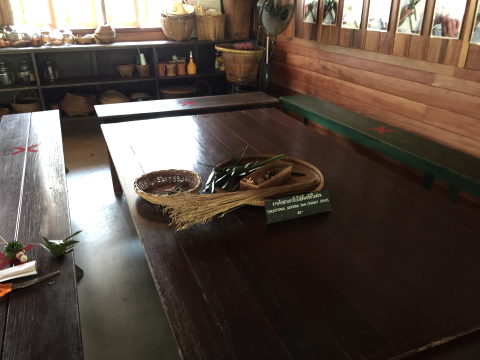
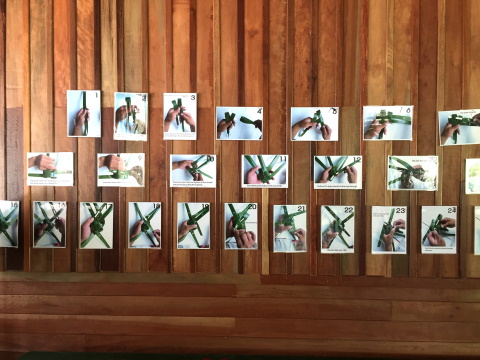
Empty workshops 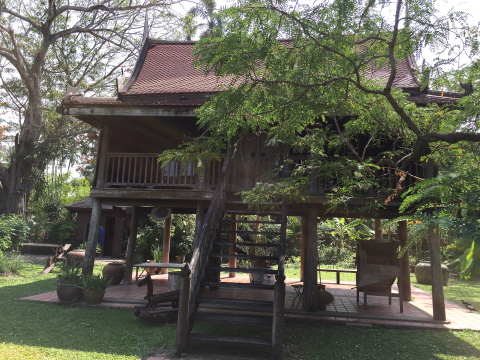
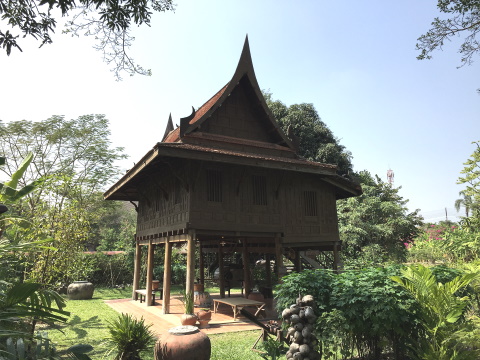
Traditional Thai house in the village In the space under the traditional Thai house there is a traditional rice mill and rattan trays for winnowing, the traditional way of separating the chaff from the grain. There is also a very interesting snippet of information on nutrition. 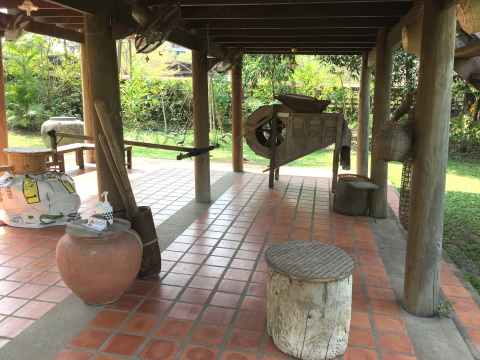
Traditional rice mill in the background and winnowing tray in the foreground In the traditional method of milling rice, the harvested rice is placed in the mill together with the husks. The wheel is turned to separate the rice grains from the husks. The process to separate the grains from the husks is called milling. The grain and chaff are placed on flat rattan trays and tossed gently in the wind which will blow away the lighter husks and leave the rice grains behind, a process called winnowing. Slow and tedious but more nutritious than the modern methods of rice milling and processing. Why? Curious, I checked with someone familiar with the modern methods of rice milling and processing. I was surprised to learn that there are five stages to this process and each stage uses a different machine.
But all the polishing and grinding have removed most of the nutrients from the rice as compared to the traditional way of doing it. Contents Organic food market The Sookjai Market within the grounds of Suan Sampran was started in 2010 to provide a retail outlet for the organic farmers participating in the Sampran Model to sell their organic agricultural products. It was the first facility we encountered during our visit to Suan Sampran. The market located in an acre of land consists of about 70 vendors selling rice, vegetables, fruits, freshly cooked food and processed food. Turnover amounts to about 3 million baht a month (about US$100,000). The market is managed by a committee elected from the vendors annually. 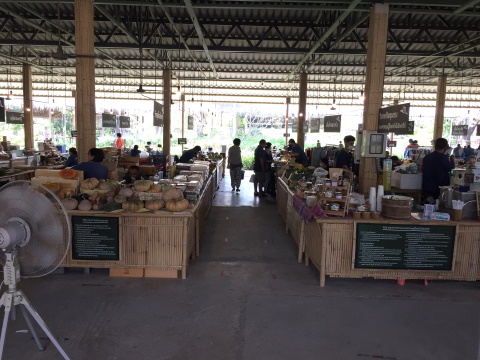
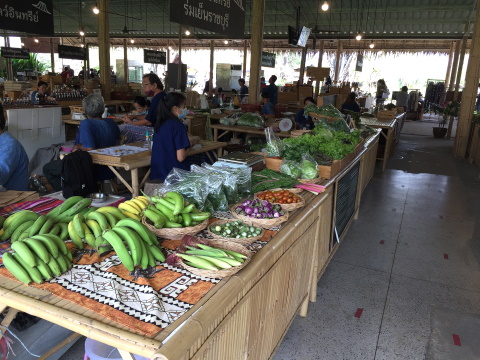
The fresh fruit section 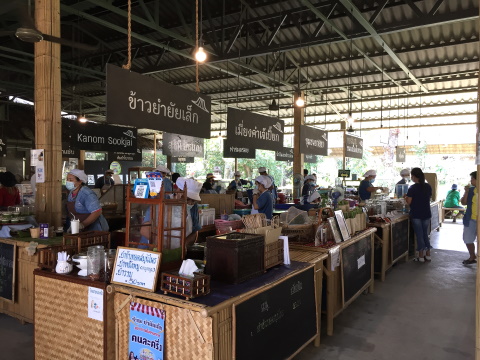
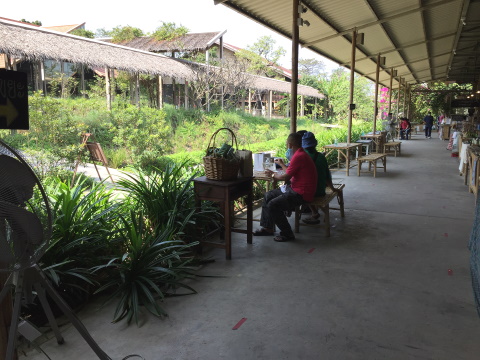
The cooked food section and dining area – note the greenery facing the diners After your meal, stroll across the garden path to the Pathom Organic Café for an organic brew and desserts. 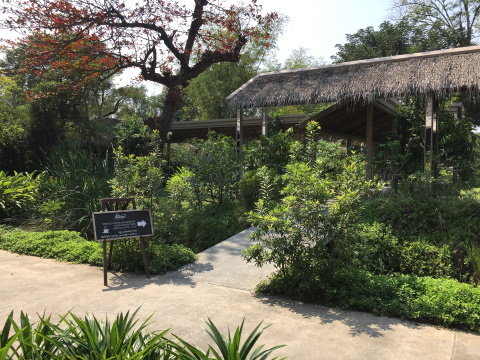
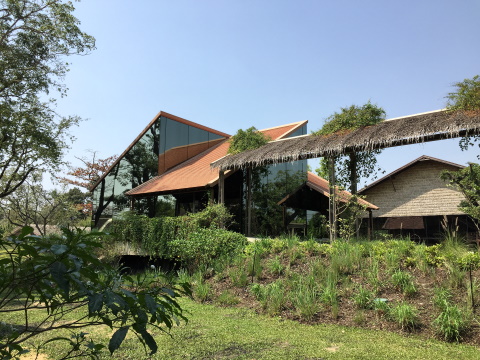
Patom Organic Café Contents Recycling and waste management This is a critical activity in the organic food production cycle. All food waste from the F & B outlets in Suan Sampran is made into organic fertiliser for the organic farm or used as animal feed and earthworm breeding. Used vegetable oil from the resort's kitchen is converted to biodiesel for use within Suan Sampran. Earthworm breeding is an interesting activity we came across in Suan Sampran. Earthworms are bred in soil mixed with organic food waste, cow manure, dead leaves and roots. 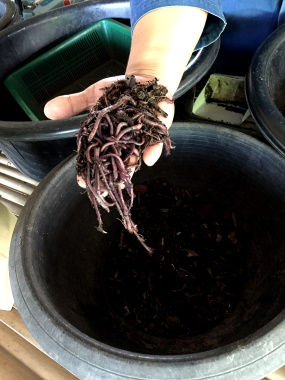
Earthworm breeding The waste from the worms and the decomposing bodies of dead worms add to the nutrients of the soil making very good fertilisers. Furthermore because of the burrowing by the worms, the earth is very fine, porous and improves the drainage of the soil. The earth in which earthworms are bred is sold as fertiliser. There is also a liquid version of the fertiliser. 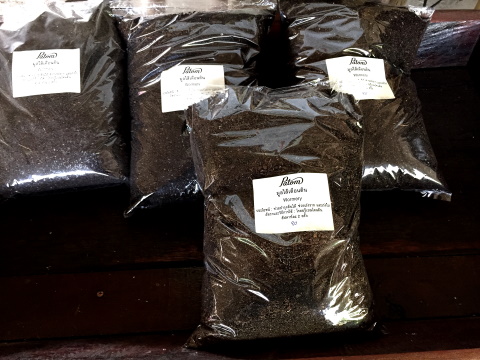
Fertiliser made from earth breeding earthworms We bought a packet home and just a small amount did wonders to our plants in the garden. Contents Preserving nature All the facilities in Suan Sampran are set in a huge ground filled with lush greenery. Of the 50 acres (20.23 hectares) in Suan Sampran, this huge and beautiful garden takes up 35 acres (14.16 hectares). There are flowers, fruit trees, bamboo clumps and a host of different flora making it a pleasure walking through this greenery. 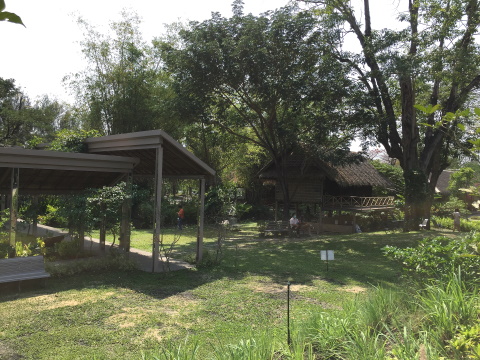
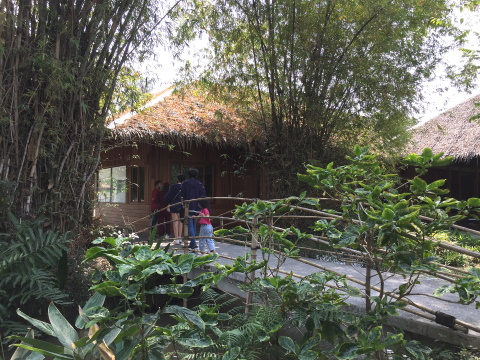
Lush greenery The current management of Suan Sampran have not only inherited their grandparents' love for nature, they have preserved the legacy of their grandparents as well. 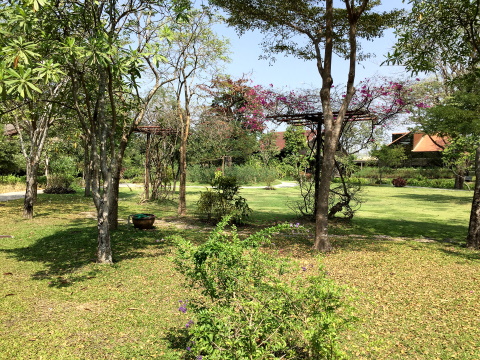
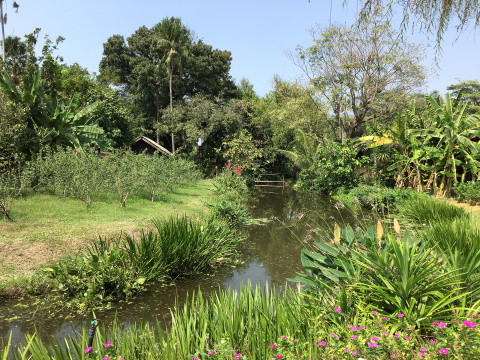
Peaceful and scenic Suan Sampran Contents Map to Suan Sampran If the map doesn’t appear, click on this link Address Suan Sampran 32 km Phetkasem Road Amphur Sampran Nakhon Pathom 73110 Thailand Contact: Tel: +66 34 322 588-93 Fax: +66 34 322 775 Email: infor@suan-sampran.com Website: www.suan-sampran.com Facebook: www.facebook.com/SuanSampran.Thailand Instagram: suansampran How to get to there From Bangkok – cross the Taksin Bridge – Krung Thonburi Road – Ratchapruek Road – turn left to Petchkasem Road at Bang Wa – continue on Petchkasem Road till you get to Suan Sampran Opening times Suan Sampran is open every day from 0900 – 1600 hours Contents Next month I'm keeping the topic open to see what comes along. I'll think of something. See you then. If you enjoyed reading this e-zine, please forward it to a friend. If you received this from a friend and found it interesting, please subscribe at Bangkok Travelbug. What do you think of the Bangkok Travelbug? We love to hear from you What other subscribers have said Visit our Tour Bangkok Legacies e-bookstore Till next month then. Eric Lim Tour Bangkok Legacies Find us on Facebook My Journey through Thailand Part I The First Steps This is my second e-book and the first in the series of travel journals on my trips to explore the various provinces in Thailand. This edition, which covers my travels from late 2009 to mid-2013, will guide you to historical sites, cultural monuments and exquisite Thai handicraft, across a vast spectrum of cultural and ethnic diversity. You can have a virtual tour with this e-guide book or take the first steps yourself in this journey through Thailand. My Kindle e-book 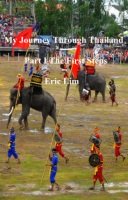
Copyright@2008-2021 Tour Bangkok Legacies All rights reserved
|
| Back to Back Issues Page |
